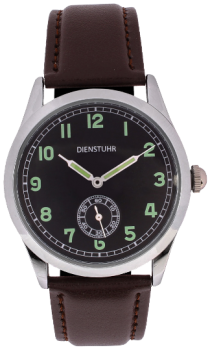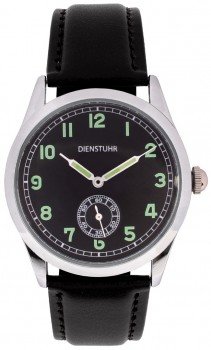WWII German military issue service watches

Published: Jun 12, 2021
WWII German military issue service watches
Wehrmacht issued WWII wrist watches were manufactured by many Swiss and German watch makers contracted by the German government. They are manually wound and most often have screw-on stainless steel case backs, are/were shock/water resistant and had a nickel plated brass (sometimes steel) watch case. The dial face was black with luminous (radium, long faded) numbers and hands with a sub seconds dial. Variations will be encountered including snap-on case backs for the German made watches. The watch case diameter will range about 34mm.
A common interpretation of the 'D' code is that it stands for Dienstuhr "Service Watch" taken together 'DH would mean Service Watch Army (Heer). Soldier's pay book records indicate that the 'D code referred to the service branch that contracted for the watches. There is evidence that 'DH coded watches were also issued to Luftwaffe personel and possibly other service organizations.DH: Dienstuhr Heer D: Dienstuhr Luftwaffe DRGM: Deutsches Reich Gebrauchsmuster
RLM: Reichsluftfahrtministerium KM: Kriegsmarine DU: Dienstuhr (Verwaltung). 'DH code, stainless steel & water proof markings. REVUE Sport and PHENIX (Swiss) Wehrmacht issue watches. 1930's (Swiss) Luftwaffe aviator.Wehrmacht issued GERMAN made watches did NOT have these 'D'codes, some German made watches for the Navy (KM, M or anchor) and Luftwaffe 'FI' (Flight) or 'RLM' (Reich Air Ministry) were coded. Imported contract watches were required to have these markings in order to facilitate contract documentation (the Wehrmacht excelled at record keeping). It is commonly felt that the GERMAN watch makers were not required to use D codes since they were closely regulated and inspected by the German Government as a matter of course.
During the 30's (German re-arming) many watches were procured adhoc without the set pattern or DH codes that developed later; This is especially true of the early Luftwaffe "aviator" watches where different patterns were purchased during the 20's and 30's. These "old timers" were issued by the Luftwaffe to their pilots throughout WWII. At the beginning of the mission the watches would be issued to the flight personnel and then be RETURNED to the unit upon the completion of the mission. The issuing unit was responsible for maintaining and ajusting these valuable timepieces, these watches were never intended for "off mission" personal use.
Towards the end of the war (and the decline of the Wehrmacht) specifications were often eased or ignored in order to meet the immediate needs of the Wehrmacht. Without a doubt, uncounted tens of thousands of timepieces that served the Wehrmacht durning WWII cannot be documented due to their being obtained outside the more "formal" channels.
(left)Visit to the salvage dump and the office for the disposition of salvage in Lublin. The following were confiscated; 60,000 watches and 800,000 wrist watches. The wrist watches will be repaired if necessary and will be handed out to front-line troops.
(right) Stowa watch contracted by the Waffen-SS (W-SS). The absence of the 'DH code is proper for this German made watch.
Collectors/buyers are often unaware of which watch companies were Swiss and which were German. Markings WILL vary depending on the contract, the country of origin, the period of the war in which the watch was obtained, and the department/branch placing the order/contract. German made watches are much less common due to Germany's production limits and the need for German watch companies to manufacture gauges and fuses to equip the Wehrmacht war machine (ships, aircraft, vehicles, artillery shells etc). This same need was faced by America during WWII and accounts for the mass introduction of Swiss made watches into the United States to meet consumer demands. This "temporary" solution contributed to the decline of the American watch industry; by the time WWII had ended the public had learned to appreciate the Swiss made watch.
Wehrmacht issued watches had the serial number recorded into the service member's pay book and the watches were expected to be returned to the service upon discharge. Period pictures show Wehrmacht personel wearing issue and non-issue watches. During the first half of the 20th century a wristwatch was a luxury item that not everyone could afford and military watches were NOT fashion items but the tools of the trade. As a general rule, the lower enlisted ranks could NOT afford a watch and their duties rarely required that they be issued one. Contracted watches seldom were able to meet the demand of the German War machine therefore watches along with other war booty (ammunition, weapons, vehicles, etc.) were often salvaged and re-issued.
1930's (Swiss) Luftwaffe Aviator watch, Kriegsmarine (Swiss) watch and a post WWII Observer watch (copy)
By no means do these Wehrmacht contract watches represent the majority of the watches that were issued to the armed forces of Germany. That "trophy" watch brought home by a WWII veteran might indeed have been "liberated" from some battlefield but conclusive documentation (for the collector) is often lacking.
The Heer, Luftwaffe and Kriegsmarine (Army, Air Force and Navy) and other German organizations each determined their own contract specifications for their watches. A common pre-WWII practice was to convert pocket watches to wrist watches by adding wire lugs (for the wrist strap) to the watch case. Due to their availability and the accuracy of the movements, it is common to find Wehrmacht wrist watches that are converted pocket watches these most often are very BIG watches, often over two inches in diameter!
The Swiss made imported watches tend to be the most common and the easiest Wehrmacht issued watches to verify IF the 'D' code and serial numbers are intact. They are of premium quality and commonly have a Swiss AS1130 movement (although other movements were used), this is an excellent movement that was used for commercial watches both before, during, and after WWII. These watches had fixed lug pins, not the spring pins common to modern day watches. A factor to consider when buying any antique watch is "are parts available for repairing the watch movement?"
A partial list of the various Swiss & German contractors are;
Arsa, Büren, BWC, Choisi, Civitas, Edo, Freco, Gala, Glycine, Grana, Helbro, Helios, Helma, Helvetia, Longines, Mimo, Minerva, Moeris, Moser, Mulco, Nisus, Phenix, Record, Recta, Revue, Stabila, Titus, Zenith, General Watch&Co, Grana, Hado, Förster Pforzheim, Gustonia, Flora, Acacia, Bulla, Era, Onda, Onsa, Alpina, Siegerin, Pronto, Monitor, Stowa, Tritona, Wagner, Aeschbach, Para, Berg, Nila, Omega, Natalia, Wempe, Geering, Bidlingmaier, Speck, Vogele, Wiemer, Tutima, Hanhart, Zentra, Selza, Aristo, Lemania, Titus, Breitling, IWC, Roamer, Rellum
Commercial versions of the Wehrmacht contract watches were produced and sold concurrently to meet consumer demands around the World making it nearly impossible to determine if an uncoded watch was a private purchase worn by a Wehrmacht service member, a civilian or were the markings later removed. Some times a soldier would remove any markings from the case back in order to conceal their military service (instant CIVILIAN watch) thus destroying any easy verification for the collector. At the end of the war many unissued watches in the government's possession had any offensive markings removed from the case backs in order to facilitate their post WWII issue.
Copies of these Wehrmacht watches were made during and after WWII, some for commercial reasons and some for military issue. Often times the copies are so close that only an examination of the watch movement indicates the country of origin and the date of manufacture. Several German watch companies reorganized and continued to manufacture their watches after the war, especially those companies located in East Germany. The Soviets were very fond of the German aviator watches and produced nice copies during and after the war and issued them to their own air forces. If you like the style and look of a German Wehrmacht wrist watch but balk at the price of an original, one of these copies might be an good choice for your consideration. However, be aware that these watches in most cases were NOT issued to the Wehrmacht and many despite the appearance of their dials (refinished?) lack any convincing documentation to the contrary.

WWII German military issue service watches
Wehrmacht issued WWII wrist watches were manufactured by many Swiss and German watch makers contracted by the German government. They are manually wound and most often have screw-on stainless steel case backs, are/were shock/water resistant and had a nickel plated brass (sometimes steel) watch case. The dial face was black with luminous (radium, long faded) numbers and hands with a sub seconds dial. Variations will be encountered including snap-on case backs for the German made watches. The watch case diameter will range about 34mm.
A common interpretation of the 'D' code is that it stands for Dienstuhr "Service Watch" taken together 'DH would mean Service Watch Army (Heer). Soldier's pay book records indicate that the 'D code referred to the service branch that contracted for the watches. There is evidence that 'DH coded watches were also issued to Luftwaffe personel and possibly other service organizations.DH: Dienstuhr Heer D: Dienstuhr Luftwaffe DRGM: Deutsches Reich Gebrauchsmuster
RLM: Reichsluftfahrtministerium KM: Kriegsmarine DU: Dienstuhr (Verwaltung). 'DH code, stainless steel & water proof markings. REVUE Sport and PHENIX (Swiss) Wehrmacht issue watches. 1930's (Swiss) Luftwaffe aviator.Wehrmacht issued GERMAN made watches did NOT have these 'D'codes, some German made watches for the Navy (KM, M or anchor) and Luftwaffe 'FI' (Flight) or 'RLM' (Reich Air Ministry) were coded. Imported contract watches were required to have these markings in order to facilitate contract documentation (the Wehrmacht excelled at record keeping). It is commonly felt that the GERMAN watch makers were not required to use D codes since they were closely regulated and inspected by the German Government as a matter of course.
During the 30's (German re-arming) many watches were procured adhoc without the set pattern or DH codes that developed later; This is especially true of the early Luftwaffe "aviator" watches where different patterns were purchased during the 20's and 30's. These "old timers" were issued by the Luftwaffe to their pilots throughout WWII. At the beginning of the mission the watches would be issued to the flight personnel and then be RETURNED to the unit upon the completion of the mission. The issuing unit was responsible for maintaining and ajusting these valuable timepieces, these watches were never intended for "off mission" personal use.
Towards the end of the war (and the decline of the Wehrmacht) specifications were often eased or ignored in order to meet the immediate needs of the Wehrmacht. Without a doubt, uncounted tens of thousands of timepieces that served the Wehrmacht durning WWII cannot be documented due to their being obtained outside the more "formal" channels.
(left)Visit to the salvage dump and the office for the disposition of salvage in Lublin. The following were confiscated; 60,000 watches and 800,000 wrist watches. The wrist watches will be repaired if necessary and will be handed out to front-line troops.
(right) Stowa watch contracted by the Waffen-SS (W-SS). The absence of the 'DH code is proper for this German made watch.
Collectors/buyers are often unaware of which watch companies were Swiss and which were German. Markings WILL vary depending on the contract, the country of origin, the period of the war in which the watch was obtained, and the department/branch placing the order/contract. German made watches are much less common due to Germany's production limits and the need for German watch companies to manufacture gauges and fuses to equip the Wehrmacht war machine (ships, aircraft, vehicles, artillery shells etc). This same need was faced by America during WWII and accounts for the mass introduction of Swiss made watches into the United States to meet consumer demands. This "temporary" solution contributed to the decline of the American watch industry; by the time WWII had ended the public had learned to appreciate the Swiss made watch.
Wehrmacht issued watches had the serial number recorded into the service member's pay book and the watches were expected to be returned to the service upon discharge. Period pictures show Wehrmacht personel wearing issue and non-issue watches. During the first half of the 20th century a wristwatch was a luxury item that not everyone could afford and military watches were NOT fashion items but the tools of the trade. As a general rule, the lower enlisted ranks could NOT afford a watch and their duties rarely required that they be issued one. Contracted watches seldom were able to meet the demand of the German War machine therefore watches along with other war booty (ammunition, weapons, vehicles, etc.) were often salvaged and re-issued.
1930's (Swiss) Luftwaffe Aviator watch, Kriegsmarine (Swiss) watch and a post WWII Observer watch (copy)
By no means do these Wehrmacht contract watches represent the majority of the watches that were issued to the armed forces of Germany. That "trophy" watch brought home by a WWII veteran might indeed have been "liberated" from some battlefield but conclusive documentation (for the collector) is often lacking.
The Heer, Luftwaffe and Kriegsmarine (Army, Air Force and Navy) and other German organizations each determined their own contract specifications for their watches. A common pre-WWII practice was to convert pocket watches to wrist watches by adding wire lugs (for the wrist strap) to the watch case. Due to their availability and the accuracy of the movements, it is common to find Wehrmacht wrist watches that are converted pocket watches these most often are very BIG watches, often over two inches in diameter!
The Swiss made imported watches tend to be the most common and the easiest Wehrmacht issued watches to verify IF the 'D' code and serial numbers are intact. They are of premium quality and commonly have a Swiss AS1130 movement (although other movements were used), this is an excellent movement that was used for commercial watches both before, during, and after WWII. These watches had fixed lug pins, not the spring pins common to modern day watches. A factor to consider when buying any antique watch is "are parts available for repairing the watch movement?"
A partial list of the various Swiss & German contractors are;
Arsa, Büren, BWC, Choisi, Civitas, Edo, Freco, Gala, Glycine, Grana, Helbro, Helios, Helma, Helvetia, Longines, Mimo, Minerva, Moeris, Moser, Mulco, Nisus, Phenix, Record, Recta, Revue, Stabila, Titus, Zenith, General Watch&Co, Grana, Hado, Förster Pforzheim, Gustonia, Flora, Acacia, Bulla, Era, Onda, Onsa, Alpina, Siegerin, Pronto, Monitor, Stowa, Tritona, Wagner, Aeschbach, Para, Berg, Nila, Omega, Natalia, Wempe, Geering, Bidlingmaier, Speck, Vogele, Wiemer, Tutima, Hanhart, Zentra, Selza, Aristo, Lemania, Titus, Breitling, IWC, Roamer, Rellum
Commercial versions of the Wehrmacht contract watches were produced and sold concurrently to meet consumer demands around the World making it nearly impossible to determine if an uncoded watch was a private purchase worn by a Wehrmacht service member, a civilian or were the markings later removed. Some times a soldier would remove any markings from the case back in order to conceal their military service (instant CIVILIAN watch) thus destroying any easy verification for the collector. At the end of the war many unissued watches in the government's possession had any offensive markings removed from the case backs in order to facilitate their post WWII issue.
Copies of these Wehrmacht watches were made during and after WWII, some for commercial reasons and some for military issue. Often times the copies are so close that only an examination of the watch movement indicates the country of origin and the date of manufacture. Several German watch companies reorganized and continued to manufacture their watches after the war, especially those companies located in East Germany. The Soviets were very fond of the German aviator watches and produced nice copies during and after the war and issued them to their own air forces. If you like the style and look of a German Wehrmacht wrist watch but balk at the price of an original, one of these copies might be an good choice for your consideration. However, be aware that these watches in most cases were NOT issued to the Wehrmacht and many despite the appearance of their dials (refinished?) lack any convincing documentation to the contrary.

Find out more:
You can find out more details about German WW2 military watches on this site